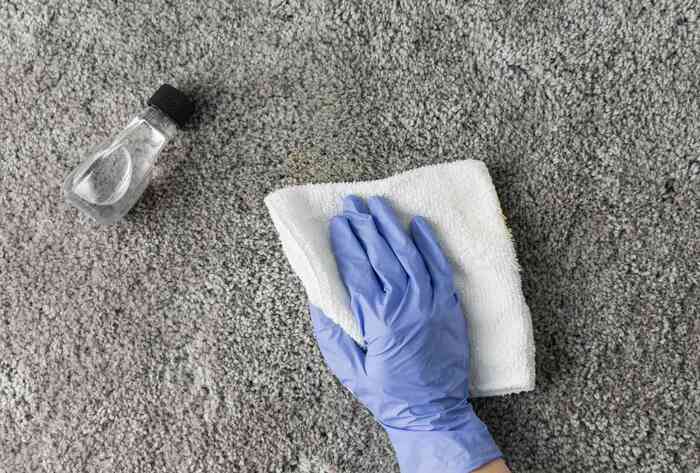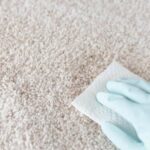Whether you’ve dropped some baby oil, cooking oil or motor oil on a carpet, oily and greasy spillages can be some of the most difficult to remove. But, with the right steps and techniques, you can win the war on getting oil stains out of your carpet.
1. Don’t leave the stain
First thing’s first – as soon as some oil gets spilled on the carpet, attend to it immediately. The faster you act, the more effective you’ll be at getting rid of the oil stain, as oil is very quickly absorbed into the fibres of the carpet and easily sticks to it.
But before you start attacking the oil spill, make sure that the cleaning methods and solutions you use are suitable for your particular type of carpet. Check the manufacturer’s cleaning instructions and assess whether the fabric type is suitable for the cleaning method you choose. As with removing any stain from a carpet, it’s a good idea to do a small patch test first in an area of the carpet that’s less conspicuous.
2. Blot the stain
Your first job is to try to remove as much of the spillage as possible by blotting it with absorbent kitchen paper or a clean cloth. Never rub at the stain or scrub at it, as this will just spread the spillage and may even set it deeper into the carpet pile.
If the oil is very sticky or thick, you can use a spoon or spatula to gently scrape the excess oil from the carpet.
3. Baking soda
Most stains, particularly water-based ones, can simply be removed by applying water to them, which absorbs the liquid in the stain. But because oil isn’t absorbed by water or bonds to it, a different approach is needed.
Fortunately, you won’t usually have to stray too far from the kitchen cupboard to find the remedies that can help. Baking soda is, for example, a good option to start with.
Baking soda is effective at absorbing oils, so sprinkle a generous amount onto the stain and leave it for up to an hour. If you don’t have any baking soda to hand, corn starch, talcum powder or polenta works in a similar way. These are inert, so they won’t cause harm to you or your carpet.
Once the time has lapsed, vacuum your carpet. If some of the oily stain still remains, you can repeat the process until the oil has been completely absorbed.
4. Washing up liquid
The next step in making sure all of the oily stain has been removed is by applying a small amount of diluted washing up liquid to the spillage. We know how effective washing up liquid can be at cutting through grease on dirty plates and pans, so it works in pretty much the same way for oil on your carpet.
Gently massage the diluted washing up liquid into the oily patch, working it deeper into the carpet with a toothbrush, if necessary, to help break down any remaining oil particles. Leave it to work for around 15 minutes. Then, blot the patch with a clean, damp cloth to extract the soapy suds from the carpet as well as the oil residues. Use paper towels to then absorb the moisture from the carpet to help it dry, which can also prevent the growth of mildew and mould in the carpet.
Allow the carpet to fully dry, either by opening the windows or using a fan, before giving it a final vacuum.
5. Dried oil
Oil that’s dried into the carpet will be harder to remove than fresh oil. That’s because it’s had longer to penetrate into the carpet and bond to its fibres. Moreover, dried oil may start to oxidise, which can change its composition, making it trickier to remove. Dried oil may also attract more dirt, and may even cause discolouration in the carpet. However, all’s not lost. Dried oil can still be removed from a carpet with a little bit of patience and persistence.
The first thing you’ll need to do is to rehydrate the oil. For most stains, you can simply do this by wetting it, but because oil and water don’t mix, this won’t work. Instead, apply a small amount of cooking oil or glycerine onto the stain. It might seem a bit counter-productive adding more oil to the carpet, but this can help to reawaken the stain, making it seem like fresh again, so it’s easier to remove it.
Next, simply follow the same procedure as you would for removing fresh oil from the carpet.
6. Isopropyl alcohol
Stubborn dried oil stains in a carpet can sometimes be resistant to baking soda and washing up liquid, in which case you might find that isopropyl alcohol, or rubbing alcohol as it’s also known, which is a type of solvent, could prove more effective.
Apply a small amount of the isopropyl alcohol to a damp cloth and dab at the oily stain. Leave the solution to work into the carpet for a few minutes, before blotting with a fresh, damp cloth. Remove excess moisture by then blotting with dry paper towels. Repeat the process, if necessary.
Isopropyl alcohol has a strong odour so ensure the room is well ventilated during the cleaning and drying process. Use this product sparingly, and always carry out a test patch first on your carpet.
Alternatively, some people find that combining equal parts of white vinegar and water to the oily stain can be an effective remedy for removing it.
It may come down to trial and error which methods you use, and which work best.
7. Professional cleaning
Since oily stains can be complex and tricky to remove yourself, potentially putting your carpet at risk of damage, it’s a good idea to contact an expert stain removal carpet cleaning company when oily spillages occur.
A professional carpet cleaning business will understand how to safely remove oily stains from different types of carpet fabrics. For example, at Carpet Bright UK, we use industrial cleaning equipment and powerful cleaning methods that can eradicate oily stains safely and without the need to use any toxic chemicals.
We also offer stain protection solutions for your carpets, so if you don’t want the headache of oily spills becoming permanent problems in the future, this can give you the peace of mind you need.
Why not call our fully insured, award-winning stain removal experts to get a free quote?







